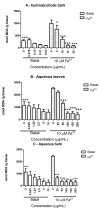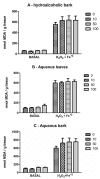Antioxidant effect of Stryphnodendron rotundifolium Martius extracts from Cariri-Ceará State (Brazil): potential involvement in its therapeutic use
- PMID: 22258340
- PMCID: PMC6268277
- DOI: 10.3390/molecules17010934
Antioxidant effect of Stryphnodendron rotundifolium Martius extracts from Cariri-Ceará State (Brazil): potential involvement in its therapeutic use
Abstract
Stryphnodendron rotundifolium is a phytotherapic used in the northeast of Brazil for the treatment of inflammatory processes which normally are associated with oxidative stress. Consequently, we have tested the antioxidant properties of hydroalcoholic (HAB) and aqueous extracts (AB) from the bark and aqueous extract (AL) from the leaves of Stryphnodendron rotundifolium to determine a possible association between antioxidant activity and the popular use of this plant. Free radical scavenger properties were assessed by the quenching of 1',1'-diphenil-2-picrylhydrazyl (DPPH) and the calculated IC(50) were: HAB = 5.4 ± 0.7, AB = 12.0 ± 2.6, and AL = 46.3 ± 12.3 µg/mL. Total phenolic contents were: HAB = 102.7 ± 2.8, AB = 114.4 ± 14.6, and AL = 93.8 ± 9.1 µg/mg plant). HPLC/DAD analyses indicated that gallic acid, catechin, rutin and caffeic acid were the major components of the crude extracts of S. rotundifolium. Plant extracts inhibited Fe(II)-induced lipid peroxidation in brain homogenates. Iron chelation was also investigated and only HBA exhibited a weak activity. Taken together, the results suggest that S. rotundifolium could be considered an effective agent in the prevention of diseases associated with oxidative stress.
Figures





Similar articles
-
Antioxidant Activity and phytochemical composition of the leaves of Solanum guaraniticum A. St.-Hil.Molecules. 2012 Oct 24;17(11):12560-74. doi: 10.3390/molecules171112560. Molecules. 2012. PMID: 23095898 Free PMC article.
-
Antioxidant activities of flavonol derivatives from the leaves and stem bark of Scutia buxifolia Reiss.Bioresour Technol. 2009 Dec;100(24):6592-8. doi: 10.1016/j.biortech.2009.03.091. Epub 2009 Aug 8. Bioresour Technol. 2009. PMID: 19666219
-
Antioxidant effects of different extracts from Melissa officinalis, Matricaria recutita and Cymbopogon citratus.Neurochem Res. 2009 May;34(5):973-83. doi: 10.1007/s11064-008-9861-z. Epub 2008 Oct 14. Neurochem Res. 2009. PMID: 18853256
-
Antioxidant activity of phenolic and flavonoid compounds in some medicinal plants of India.Nat Prod Res. 2011 Jul;25(11):1101-9. doi: 10.1080/14786419.2010.498372. Nat Prod Res. 2011. PMID: 21726132
-
Culture matters: A systematic review of antioxidant potential of tree legumes in the semiarid region of Brazil and local processing techniques as a driver of bioaccessibility.PLoS One. 2022 Mar 9;17(3):e0264950. doi: 10.1371/journal.pone.0264950. eCollection 2022. PLoS One. 2022. PMID: 35263378 Free PMC article.
Cited by
-
Antioxidant Activity of Stryphnodendron rotundifolium Mart. Stem Bark Fraction in an Iron Overload Model.Foods. 2021 Nov 3;10(11):2683. doi: 10.3390/foods10112683. Foods. 2021. PMID: 34828960 Free PMC article.
-
Analysis of the Variability of Therapeutic Indications of Medicinal Species in the Northeast of Brazil: Comparative Study.Evid Based Complement Alternat Med. 2018 Apr 23;2018:6769193. doi: 10.1155/2018/6769193. eCollection 2018. Evid Based Complement Alternat Med. 2018. PMID: 29849720 Free PMC article.
-
Stryphnodendron Species Known as "Barbatimão": A Comprehensive Report.Molecules. 2018 Apr 15;23(4):910. doi: 10.3390/molecules23040910. Molecules. 2018. PMID: 29662029 Free PMC article. Review.
-
Advances in Evaluation of Antioxidant and Toxicological Properties of Stryphnodendron rotundifolium Mart. in Drosophila melanogaster Model.Foods. 2022 Jul 27;11(15):2236. doi: 10.3390/foods11152236. Foods. 2022. PMID: 35954004 Free PMC article.
-
The use of herbs against neglected diseases: Evaluation of in vitro leishmanicidal and trypanocidal activity of Stryphnodendron rotundifolium Mart.Saudi J Biol Sci. 2017 Sep;24(6):1136-1141. doi: 10.1016/j.sjbs.2015.03.001. Epub 2015 Mar 7. Saudi J Biol Sci. 2017. PMID: 28855804 Free PMC article.
References
-
- Halliwell B. Free radicals, antioxidants and human diseases: Curiosity, cause or consequences. Lancet. 1994;334:721–724. - PubMed
-
- Jomova K., Jenisova Z., Feszterova M., Baros S., Liska J., Hudecova D., Rhodes C.J., Valko M. Arsenic: Toxicity, oxidative stress and human disease. J. Appl. Toxicol. 2011;31:95–107. - PubMed
-
- Jomova K., Vondrakova D., Lawson M., Valko M. Metals, oxidative stress and neurodegenerative disorders. Mol. Cell. Biochem. 2010;345:91–104. - PubMed
-
- Giorgio M., Trinei M., Migliaccio E., Pier G.P. Hydrogen peroxide: A metabolic by-product or a common mediator of ageing signals? Nat. Rev. Mol. Cell Biol. 2007;9:722–728. - PubMed
Publication types
MeSH terms
Substances
LinkOut - more resources
Full Text Sources
Other Literature Sources
Medical
Miscellaneous

